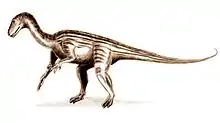Magnesian Conglomerate
The Magnesian Conglomerate is a geological formation in Clifton, Bristol in England (originally Avon), Gloucestershire and southern Wales, present in Tytherington, Durdham Down and Cromhall Quarry. It dates back to the Rhaetian stage of the Late Triassic,[1][2] although it may be as old as the Norian stage of the Late Triassic and as young as the Hettangian stage of the Early Jurassic. This formation was first discovered in autumn 1834 and was studied in 1836 by Henry Riley and Samuel Stutchbury.[3]
| Magnesian Conglomerate | |
|---|---|
| Stratigraphic range: Rhaetian ~ | |
 Cromhall Quarry, where an outcrop of the Magnesian Conglomerate is present | |
| Type | Geological formation, fissure fill |
| Underlies | none |
| Overlies | Friars Point Limestone Formation? |
| Lithology | |
| Primary | Breccia |
| Other | Limestone |
| Location | |
| Coordinates | 51.5°N 2.6°W |
| Approximate paleocoordinates | 35.9°N 0.8°E |
| Region | South West England & South Wales |
| Country | |
| Extent | Bristol |
| Type section | |
| Named by | Henry Riley & Samuel Stutchbury |
| Year defined | 1836 |
 Magnesian Conglomerate (England) | |
The Avon Fissure Fill is probably the same formation as the Magnesian Conglomerate.[1]
Vertebrate paleofauna
| Taxon | Species | Presence | Notes | Images |
|---|---|---|---|---|
| Hwiccewyrm[4] | H. trispiculum[4] | Geographically present in Cromhall Quarry.[4] | Several specimens comprising a partial skeleton.[4] Discovered during the 1970s and listed as cf. Hypsognathus by Whiteside et al. (2016).[5] | |
| Palaeosaurus[2][6] | P. cylindrodon[2][6] | Geographically present in Avon, England (now Bristol) and Bristol.[2] | Two teeth (one destroyed in 1940).[2] |  |
| Theropoda[2] | Indeterminate[2] | Geographically present in Avon, England (now Bristol) and Bristol.[2] | Indeterminate remains.[2] Possibly similar to Pendraig milnerae.[7] | |
| Thecodontosaurus[2] | T. antiquus[2] | Geographically present in Avon, England (now Bristol) and Bristol.[2] | Partial cranial and postcranial remains (holotype is a lower jaw).[2] |  |
See also
References
- Magnesian Conglomerate in the Paleobiology Database
- Weishampel et al., 2004, pp. 521–525
- Riley & Stutchbury, 1836
- Butler, R. J.; Meade, L. E.; Cleary, T. J.; McWhirter, K. T.; Brown, E. E.; Kemp, T. S.; Benito, J.; Fraser, N. C. (2023). "Hwiccewyrm trispiculum gen. et sp. nov., a new leptopleuronine procolophonid from the Late Triassic of southwest England". The Anatomical Record. doi:10.1002/ar.25316. PMID 37735997.
- Whiteside, D. I., Duffin, C. J., Gill, P. G., Marshall, J. E. A., & Benton, M. J. (2016). The Late Triassic and Early Jurassic fissure faunas from Bristol and South Wales: Stratigraphy and setting. Palaeontologia Polonica, 67, 257–287.
- Galton, Peter (2007). "Notes on the remains of archosaurian reptiles, mostly basal sauropodomorph dinosaurs, from the 1834 fissure fill (Rhaetian, Upper Triassic) at Clifton in Bristol, southwest England". Revue de Paléobiologie. 26 (2): 505–591.
- Spiekman SN, Ezcurra MD, Butler RJ, Fraser NC, Maidment SC (2021). "Pendraig milnerae, a new small-sized coelophysoid theropod from the Late Triassic of Wales". Royal Society Open Science. 8 (10): Article ID 210915. doi:10.1098/rsos.210915. PMC 8493203. PMID 34754500.
Bibliography
- Foffa, D.; D. I. Whiteside; P. A. Viegas, and M. J. Benton. 2014. Vertebrates from the Late Triassic Thecodontosaurus-bearing rocks of Durdham Down, Clifton (Bristol, UK). Proceedings of the Geologists' Association 125. 317–332. .
- Weishampel, David B.; Peter Dodson, and Halszka Osmólska (eds.). 2004. The Dinosauria, 2nd edition, 1–880. Berkeley: University of California Press. Accessed 2019-02-21. ISBN 0-520-24209-2
- Riley, H., and S. Stutchbury. 1836. A description of various fossil remains of three distinct saurian animals discovered in the autumn of 1834 in the Magnesian Conglomerate on Durdham Down near Bristol. Proceedings of the Geological Society 2. 397–399. .
Further reading
- Riley, H. and Stutchbury, S. 1840. A description of various fossil remains of three distinct saurian animals recently discovered in the Magnesian Conglomerate near Bristol Transactions of the Geological Society of London 5, 349–357
- W. Buckland. 1824. Reliquiæ Diluvianæ; or, Observations on the Organic Remains Contained in Caves, Fissures, and Diluvial Gravel, and on Other Geological Phenomena, Attesting the Action of an Universal Deluge. Second Edition. John Murray, London 1-303
External links
This article is issued from Wikipedia. The text is licensed under Creative Commons - Attribution - Sharealike. Additional terms may apply for the media files.